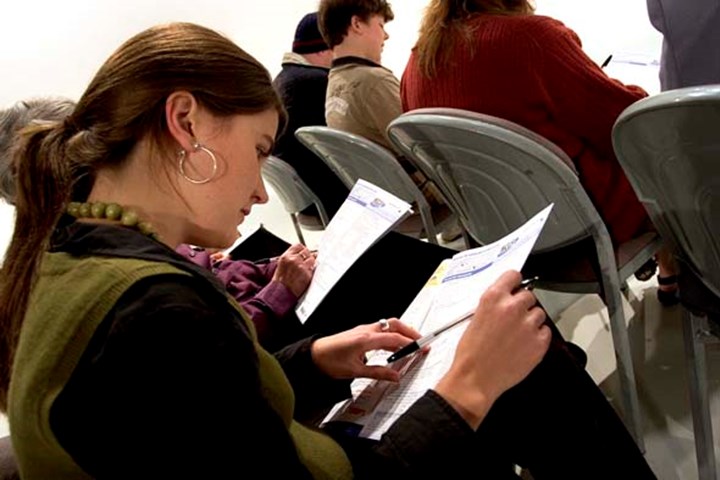In addition, there is information about the survey design and method. There are 62 different survey variants that are distributed to church adult and child attenders, church leaders and administrators. There are 10 translations of the attender survey including English, Chinese, Korean, Vietnamese, Italian, Tongan, Dinka (Sudanese), Arabic, Chin (Burmese) and Karen (Burmese). There is also a list of the research modules and an outline of the contents of each of the survey instruments.
• View 2021 NCLS Survey Design and Method

Introduction
The 2021 National Church Life Survey (2016 NCLS) project has two broad goals: resourcing churches and research.
This Research Plan is related to the second broad goal. Resulting datasets are used for various research programs and projects.
Summary of NCLS Research Programs
NCLS Research has five broad research programs under which various research projects are located.
• Program 2: Mapping the intersection between church and community
• Program 3: Spirituality, wellbeing and psychology of religion in church life
• Program 4: Who goes to church and tracking trends in church life over time
• Program 5: Cultures and generations in church life
In addition to these five programs, the 2021 NCLS will have two extra programs to cover commissioned research.
Partners
As a joint venture, the 2021 NCLS project needs to meet diverse needs of multiple partners.
These can be clustered into three groups:
• Academic work by NCLS researchers
• Resources for the scholarly community
• Church and industry partners
Overview of NCLS Research Programs
A brief overview of each of the five program areas is provided below.

Organisational effectiveness is of interest not only to business and non-profit organizations, but also to Christian churches. Measurement is complex and the trend is towards multi-dimensional, multi-stakeholder models. This project focuses on leadership and organisational effectiveness in Christian churches.
We will conduct a multi-disciplinary literature review and address research questions using National Church Life Survey (1991 to 2016) datasets, a longitudinal study of thousands of local churches.
With churches as the unit of study, we will measure effectiveness or ‘vitality’ (using the NCLS framework of nine core qualities of church health and three measures of attendance particularly), identify high-performing or ‘lighthouse’ churches for further investigation, and explore social capital, and innovative or entrepreneurial activity.
We will also look at the role of leadership, both in terms of the style and role of the leader as well as relational processes. Distributed leadership, empowering leadership and social change leadership are potential frameworks.
This research program is at the heart of the NCLS agenda, where we focus on local churches as agents of God’s mission.

Churches are renegotiating their place and role in contemporary Australian society. This project maps the interplay between churches and the wider community.
At the macro level, we look at changes in the social and cultural context and the role of churches in providing local faith communities, church schools and church-based community services. How do church attenders share beliefs and values? We also assess inflow of newcomers.
We evaluate the impact by churches in public policy areas such as integration of new migrants into society, advocacy on social issues, or on environmental attitudes and behaviours.

This program focuses on individual differences, drawing from the discipline of psychology. We will review both attitudes and behaviours of church attenders and local church leaders. The impact of personality differences across different questions will be explored. The intersection between spirituality and wellbeing among attenders and leaders is of interest.
One key focus will be on sustainable leadership, which refers to the resilience and wellbeing of individual leaders. This strand of the research program focuses on identifying factors that help individuals to thrive and guard against burnout. Another aspect of this work covers hope and optimism.

This project is about the characteristics of those who attend activities of local congregations. We describe their demographic profile, including variations across denominations and changes over time, and examine differences between newcomers to church, those who have recently changed churches, and longer term attenders.
We will also examine the characteristics of attenders who indicate that they are likely to leave church. There is a particular emphasis on age, assessing both stage of life and generational differences.
We also profile attitudes and behaviours of church attenders and leaders, particularly to do with denominational/local church issues such as attitude to financial giving, denominational beliefs and practices (e.g. ordination of women), interfaith relations etc.
An ongoing project is the estimate of church attendance. This is used to assess which parts of the Church are growing, stable or declining.

This research strand is concerned with diverse population groups in church life. Three particular research focuses are: children and youth/generational issues, multicultural ministry, indigenous and non-indigenous relations.
Re children and youth: As younger people disengage from organised religion, we are interested in attitudes and experiences regarding spirituality and church life. We are also interested in examining the characteristics of churchgoing parents whose children still attend church.
Re cultural models of church: Churches play a critical role in the social capital of migrant communities. We will review attitudes about migrants and connections by churches. We will evaluate differences between multi-ethnic groups and mono-ethnic groups (including comparing and contrasting different migrant groupings) in terms of church health and differences between generations.
Re indigenous relations: We are interested in the lessons to be learnt from indigenous faith communities and the impact on their own participants as well as the wider church and society.

In the 2021 NCLS, the primary sponsors of NCLS Research are given an opportunity to collect data for their own additional specific research agendas. These primary sponsors include the Anglicare Sydney; Uniting and Uniting Mission and Education (Synod of NSW & the ACT); and BaptistCare NSW/ ACT.
Denominations were also offered the opportunity to customise the main Attender Survey A for their congregations. They could also add questions to the Operations and Leaders Surveys.
Program 7: Other commissions
In the 2021 NCLS, other agencies are offered the opportunity to commission questions in some of the survey instruments.
See also 2021 NCLS Survey Design and Method.
2021 NCLS: Research Programs and Projects Overview Map
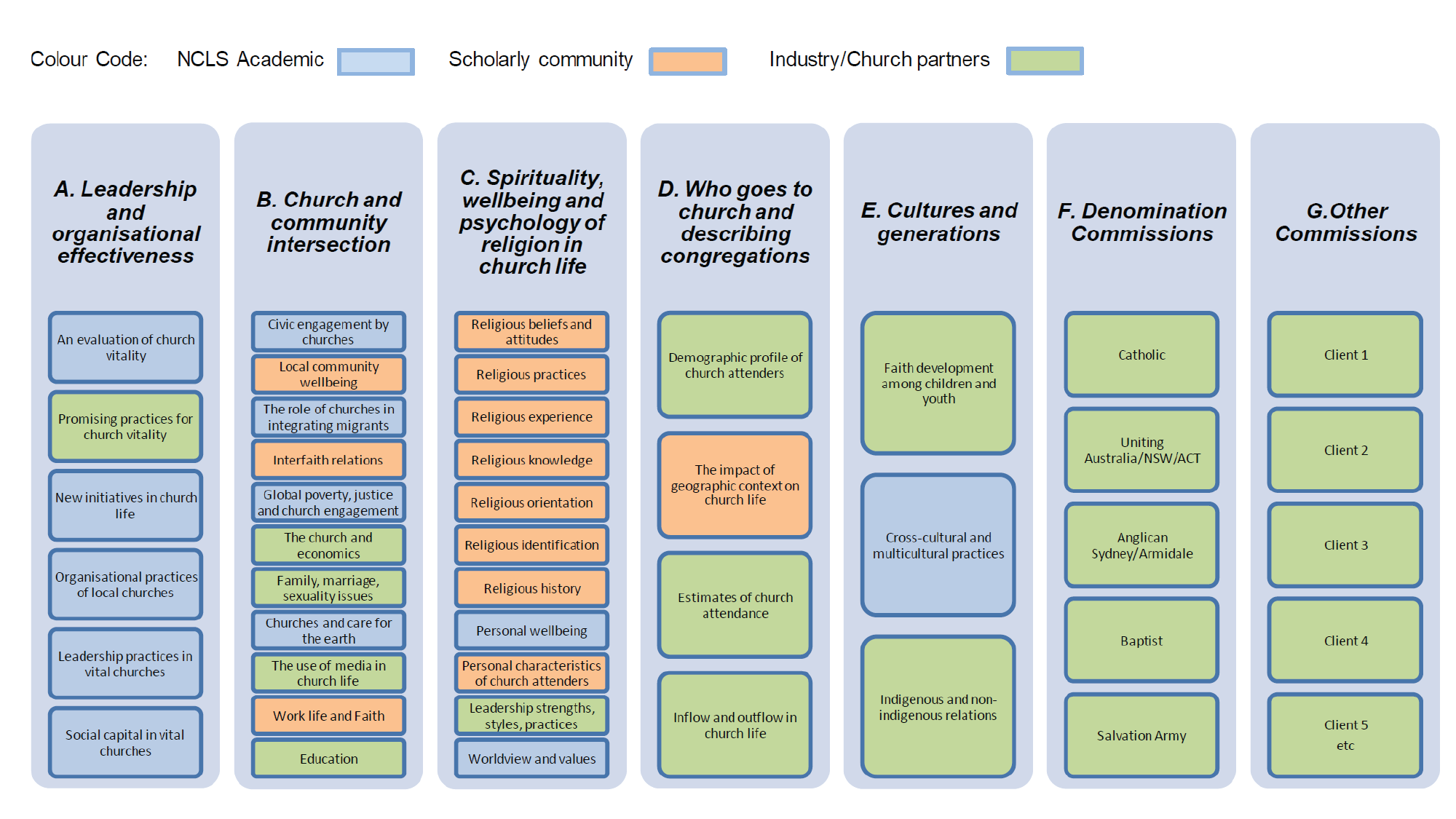

The National Church Life Survey (NCLS) is a local church-based survey which surveys Christian churchgoers across Australia. It commenced in 1991 and has been conducted every five years since.
The 2021 NCLS is the seventh wave of the NCLS, involving some 3,000 local churches from 21 denominations, which represents 25% of the estimated number of local churches in Australia (not including Orthodox, independent and house churches).
The Attender Survey consists of a main survey (available in 8 languages) which is completed by most participants and a series of smaller sample surveys (in English only), each of which is a random sample of the total participants (Pepper, Sterland & Powell, 2015).
Data are weighted to account for different levels of participation among church denominations and regions (e.g. states, dioceses, synods).
Survey Variants
In total, the 2016 NCLS included 62 different survey variants. These will be reviewed for 2021.
| SURVEY TYPE | # |
| Attender Survey A | 7 |
| Attender Sample Surveys | 26 |
| Translations | 24 |
| Operations | 2 |
| Leader | 2 |
| Child | 1 |
| TOTAL | 62 |
Attender Survey A
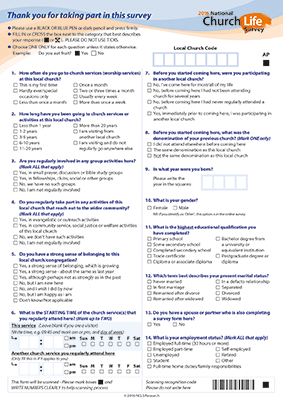
Attender Survey A is completed by the majority of all church attenders in a local church. The content of these surveys are the bedrock of the vitality research and the source of the vitality Church Life Profiles for all participants. There is a Protestant version (AP) and a Catholic version (AC). The AP survey is completed by ~85% of Protestant attenders in each congregation and the AC Survey is completed by ~67% of attenders in each Catholic parish.
In 2021 some denominations and regions customised their Survey A and added extra questions for attenders in their churches.
Attender Survey A Translations
Survey A was translated to the following languages: Chinese, Vietnamese, Korean, Arabic, Dinka (Sudanese), Chin (Burmese) and Karen (Burmese).
Attender Sample Surveys
Most attenders receive a Main Attender Survey form, which is used to generate Church Life Profile results for local churches, regions and denominations. The remaining attenders receive one of a number of Attender Sample Survey forms, which are included at random in the bundle of survey forms ordered by the church. Approximately 60% of the content in the Sample Surveys is taken up with a core component from the Main Attender Survey. The remainder consists of unique questions that progress a whole range of research agendas concerned with the characteristics, attitudes and practices of Australian church attenders. A wide variety of consultants were invited to contribute to the design process.
Attender Sample Survey Research Modules
| Leadership and organisational effectiveness | An evaluation of church vitality |
| Promising practices for church vitality | New initiatives in church life |
| Organisational practices of local churches | Leadership practices in vital churches |
| Social capital in vital churches | Church and community intersection |
| Civic engagement by churches | Local community wellbeing |
| The role of churches in integrating migrants | Interfaith relations |
| Global poverty and justice and church engagement | The church and economics |
| Family, marriage, sexuality issues | Churches and care for the earth |
| The use of media in church life | Work life |
| Education | Psychology of religion and positive psychology in church life |
| Religious beliefs and attitudes | Religious practices |
| Religious experience | Religious knowledge |
| Religious orientation | Religious identification |
| Religious history | Personal wellbeing |
| Personal characteristics of church attenders | Leadership strengths, styles, practices |
| Worldview and values | Who goes to church and describing congregations |
| Demographic profile of church attenders | The impact of geography on church life |
| Estimates of church attendance | Inflow and outflow in church life |
| Cultures and generations | Faith development among children and youth |
| Cross-cultural and multicultural practices | Indigenous and non-indigenous relations |
Child Survey for 8 to 14 year olds
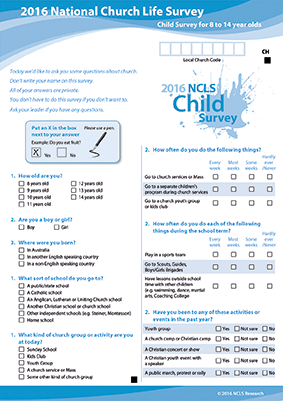
We are interested in attitudes and experiences regarding spirituality and church life. We are also interested in examining the characteristics of churchgoing parents whose children still attend church. We have a 4 page Child Survey for the 2021 NCLS.
Overall, main priorities are:
• Child spirituality/spiritual formation/discipleship: What are the religious experiences, beliefs and practices of children connected with churches?
• Church, faith and family: How do local churches most effectively help families to nurture and pass on faith? What happens in the family/home setting?
In addition, on the Parent Information Sheet, we have also promoted the idea of the new project - a longitudinal panel that would run for 3 to 5 years. This is just an expression of interest from parents. Once we have finalized the project design and funding, then we will contact all who have expressed interest and invite them to sign up properly.
Church Census Form
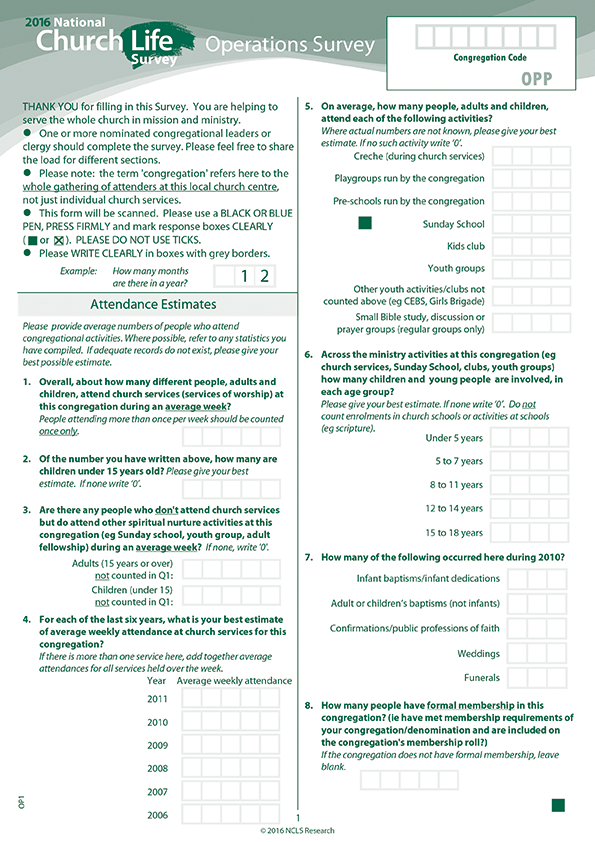
All churches will be asked to describe their resources:
people, staff and activities.
Leader Survey

The Leader Survey is a 12 page survey. There are two versions: LS1 and LS2. Each one is divided into two parts.
Part A is for anyone in pastoral/ministry leadership (e.g. deacons, parish council members etc.). It is relatively short. Part B makes up the remainder and is for pastoral/ministry staff (e.g. ministers/priests, associates, youth workers etc.).
These are the modules of questions in the 2021 NCLS Leader Survey.
1. Roles and Staffing.
2. Demographics.
3. Effective Leadership.
a. Leadership strengths and styles.
b. Team issues.
c. Promising practices and church vitality.
d. Social capital.
e. Innovation and New Initiatives.
4. Sustainable Leadership.
a. NCLS Personal Foundations.
b. Support and mentoring.
c. Personality.
5. Leader Well-being.
a. Physical health.
b. Burnout and thriving in ministry.
c. Stress, anxiety and depression.
d. Personal well-being.
e. Work engagement.
6. Faith and Spirituality.
a. Personal beliefs and orthodoxy.
b. Experiences, practices, and orientations.
7. Training.
a. Current level and time of training.
b. Areas of need for further training.
8. Attitudes.
a. Political and social issues.
b. Interface with church practices.
c. Schools and education.
d. Interfaith issues.
9. Church Governance.
a. Overall practice and perceived effectiveness.
b. Features of church councils/boards.
10. Commissioned Questions.
a. 7 clients.

.png)
